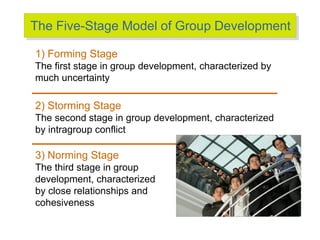The document discusses several key concepts relating to groups and teams:
1) It defines groups as two or more individuals interacting to achieve objectives, and classifies groups as formal or informal.
2) It outlines the five stages of group development: forming, storming, norming, performing, and adjourning.
3) It discusses important group properties like roles, norms, size, and cohesiveness that impact performance.
4) Factors that influence effective group decision making are examined, along with potential pitfalls like groupthink.




























